Abstract
Data on harvest yields, planted area, and shipping volumes for winter-spring strawberry farming in Japan goes back to 1990. The national harvest was 216kt, with a cultivated area of 10.1kha and Tochigi having the largest shipping volume at 21.6kt. These figures suggest a trend: strawberry farming is widespread throughout the country, with Tochigi doing particularly well in terms of shipping volume. However, there is no data available after 1990, so there is no information on changes or growth since then. A general characteristic appears to be that there is high demand for strawberries, but details such as the relationship between production volume and shipping volume, or the progress of cultivation techniques in each region are unknown.
Winter and spring strawberry harvest yields (main data).
Between 1973 and 1990, Japan’s winter-spring strawberry harvests fluctuated. The peak was recorded in 1988 at 218kt nationwide, and has been declining since then. Current yields are at 99% of their peak and show signs of long-term stability. The decline is thought to be due to changes in the production environment resulting from technological innovation in agriculture and economic changes. Changes in demand and markets may also be playing a role. On the other hand, demand for strawberries remains consistently high, and there is a need to restructure production systems and improve quality in response to the increased demand. In the future, it will be important to establish sustainable agricultural models and adapt them to consumer needs.
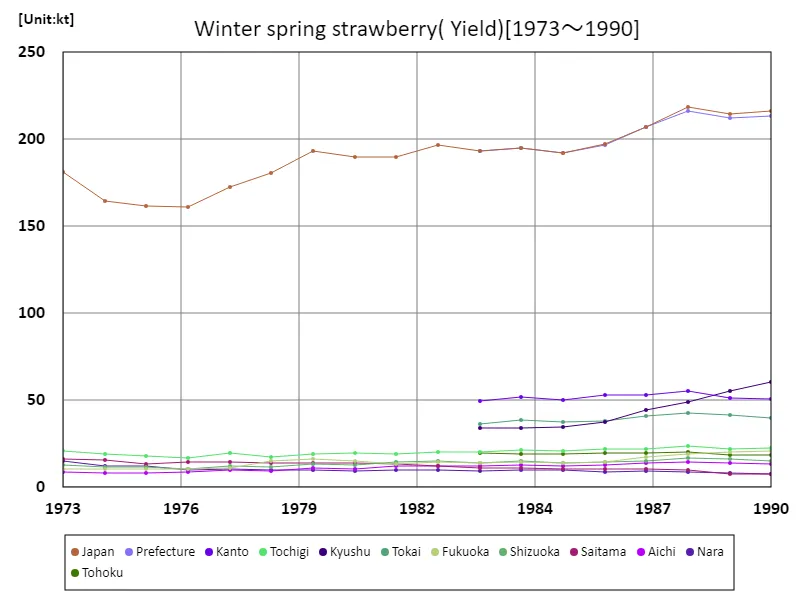

The maximum is 218kt[1988] of Japan, and the current value is about 99%
Winter and spring strawberry harvest volumes (by prefecture).
According to prefecture-by-prefecture data, the yield of fruit vegetables in Japanese agriculture reached its highest level in 1990. Tochigi achieved the highest overall score of 22.6kt, which remains the highest to date. This trend suggests that Tochigi is particularly good at producing fruit vegetables. The reasons why Tochigi has an advantage over other regions include its climatic conditions, soil suitability, and advances in agricultural technology. Changes in consumer demand and markets may also be affecting local production. In the future, it will be important for other regions, including Tochigi, to build sustainable production systems and strive to maintain and increase production volumes in line with demand.
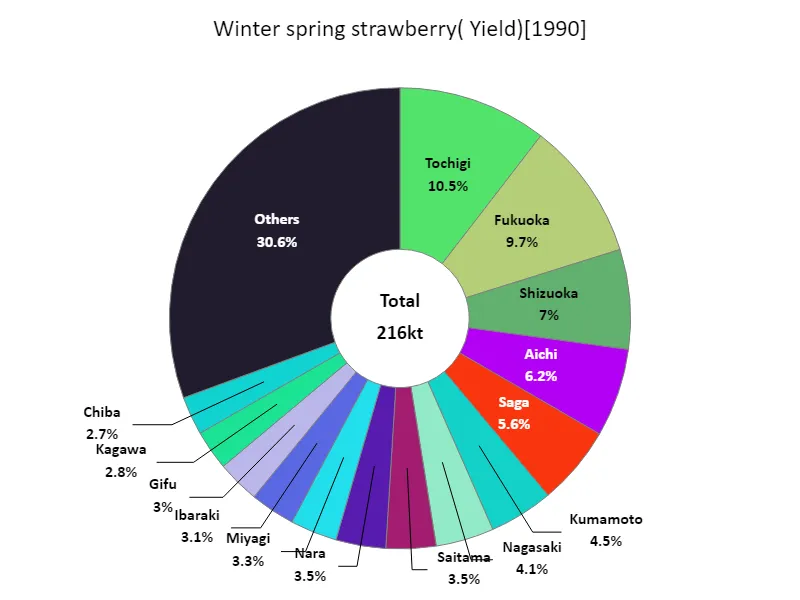

The maximum is 22.6kt of Tochigi, the average is 4.6kt, and the total is 216kt
Area planted with winter/spring strawberries (main data).
The area of land cultivated with winter/spring strawberries in Japanese agriculture reached a peak of 12.9 kha nationwide in 1973 and has since been on a downward trend, currently standing at 78.3% of its peak. This trend may be due to structural changes in agriculture and changes in market demand. It is believed that in 1973, the demand for strawberries was on the rise, which encouraged farmers to cultivate them. However, subsequent economic and consumption changes may have increased demand for other vegetables and fruits, resulting in a decline in the area cultivated with strawberries. Additionally, advances in agricultural technology and increased productivity may lead to a tendency to reduce the area while maintaining the same yield. In the future, it will be necessary to establish a sustainable cultivation system that can respond flexibly to changes in demand and consumer preferences.
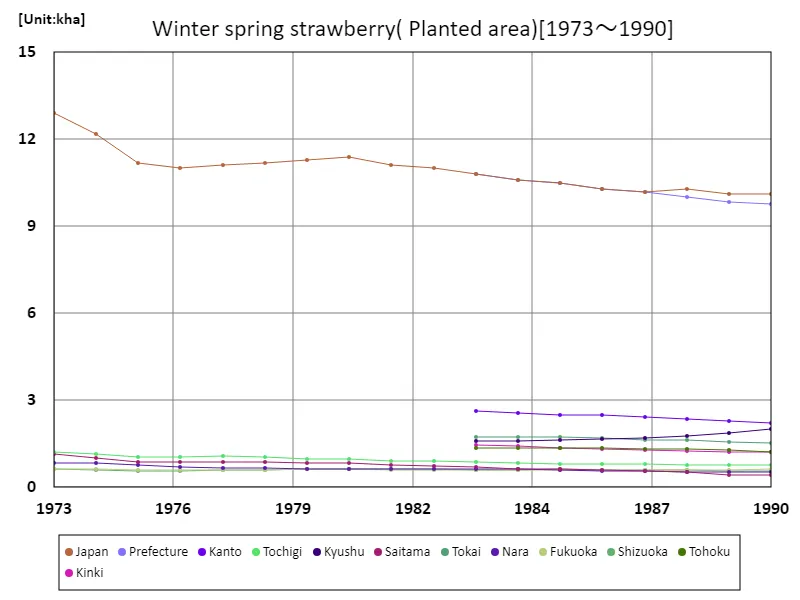

The maximum is 12.9kha[1973] of Japan, and the current value is about 78.3%
Areas cultivated for winter and spring strawberries (by prefecture).
In 1990, Tochigi had the largest area of land devoted to fruit vegetables in Japanese agriculture, at 757 hectares, which remains the largest to this day. This data suggests that Tochigi is particularly good at cultivating fruit-like vegetables. The reasons why Tochigi leads other regions include its geographical conditions, climate, soil suitability, and advances in agricultural technology. Local agricultural policies, support systems, and the organizational strength of farmers may also be influential. Based on past trends, it appears that Tochigi has an advantage in cultivating fruit vegetables, with other regions also actively producing them. In the future, further improvements in cultivation techniques and the establishment of sustainable agricultural models will be required, and regional cooperation and information sharing will become important.
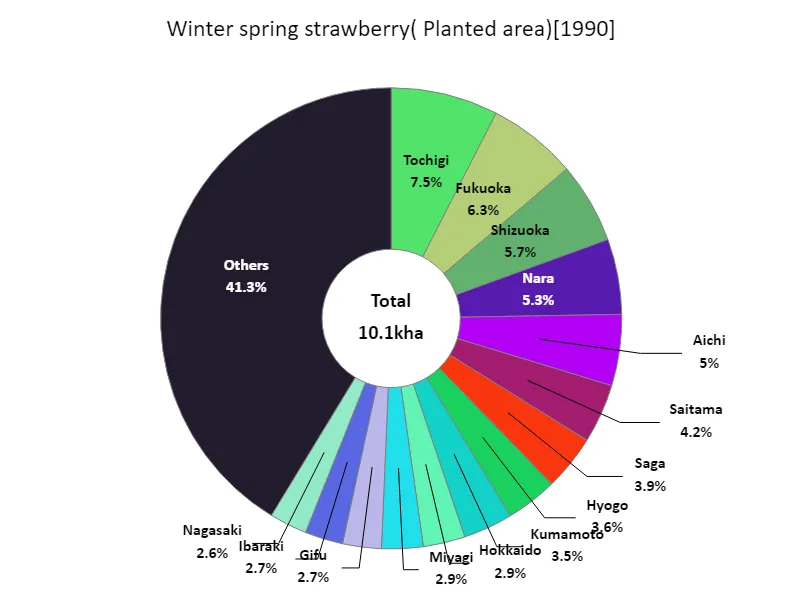

The maximum is 757ha of Tochigi, the average is 214ha, and the total is 10.1kha
Winter and spring strawberry shipments.
In 1990, the total shipping volume of winter-spring strawberries in Japanese agriculture was 196kt, with Tochigi having the highest overall volume at 21.6kt and an average of 4.16kt. This data shows that Tochigi is the largest producer of winter-spring strawberries in terms of shipping volume. Tochigi’s lead over other regions can be attributed to its favorable climate and soil conditions, as well as advances in agricultural technology. Local agricultural policies, support systems, and the organizational strength of farmers may also be influential. On the other hand, the total shipping volume was 196kt, indicating high demand for winter-spring strawberries. It will be important to adjust shipping volumes between regions and improve transportation systems in response to consumer demand. In the future, it will be necessary to respond flexibly to changes in demand and establish a sustainable production system.
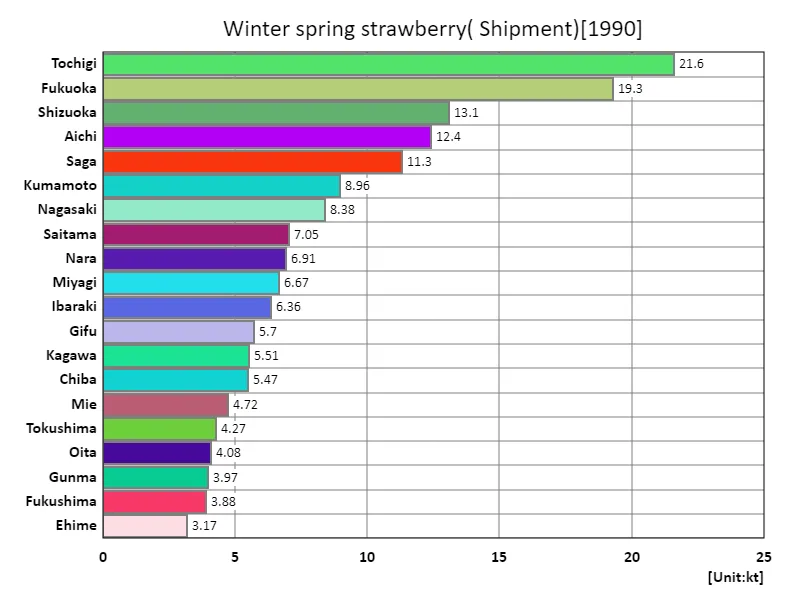

The maximum is 21.6kt of Tochigi, the average is 4.16kt, and the total is 196kt



Comments